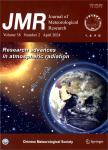Spatial and Temporal Validation of In-Situ and Satellite Weather Data for the South West Agricultural Region of Australia
Spatial and Temporal Validation of In-Situ and Satellite Weather Data for the South West Agricultural Region of Australia作者机构:Centre for Mine Site RestorationCurtin University of TechnologyWA 6102Australia Remote Sensing and Satellite Research GroupCurtin University of TechnologyWA 6102Australia
出 版 物:《Journal of Meteorological Research》 (气象学报(英文版))
年 卷 期:2022年第36卷第1期
页 面:175-192页
核心收录:
主 题:Australian Water Availability Project land surface temperature satellite precipitation validation
摘 要:Seasonal variations in weather have significant impacts on crop *** accuracy of weather data is an important consideration for crop yield *** study uses an independent in-situ weather station network to validate the accuracy of monthly temperature and precipitation data from the in-situ weather station network operated by the Bureau of Meteorology(BOM),interpolated gridded data from this network,and satellite weather data for the South West Agricultural Region of *** region covers five classes of the K?ppen-Geiger climate classification system and is responsible for 10 billion AUD of agricultural produce annually.A strong bias was found for the maximum temperatures in the Copernicus LST(land surface temperature)satellite *** bias was linearly correlated with the in-situ temperature and exceeded 20℃in warmer *** to the bias’s linear nature,a linear correction was able to reduce the root-mean-square error(RMSE)of the Copernicus LST product by 82%.This process was tested for other regions of Australia and,despite some regional differences,a linear correction consistently reduced RMSE by 80%.The validation process demonstrated that the dataset with reliably the lowest RMSE is the gridded weather data calculated from BOM’s in-situ weather *** neighbor in-situ weather stations generally had the next lowest RMSE,followed by weather-station corrected satellite products and lastly the non-weather station corrected satellite *** the in-situ gridded product generally had the lowest RMSE,there were spatial and seasonal *** maximum temperatures were more accurately measured by the bias-corrected Copernicus LST product in the northern and eastern extents(where there is a lower density of BOM in-situ stations).Monthly minimum temperatures from the Copernicus LST product had similar to slightly better RMSE than the Australian Water Availability Project(AWAP)product for the southern half of the study ar



